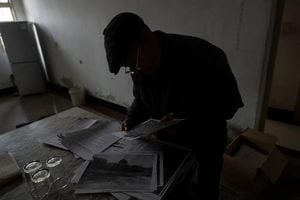Concerns are mounting as the Democratic Republic of Congo grapples with the spread of a mysterious illness, speculated to be connected to various underlying health issues, particularly affecting children. Over the past few weeks, this situation has raised alarms and spurred international responses as doctors, health officials, and lawmakers scramble to tackle the potential risk of this unexplained disease, which has resulted in numerous casualties.
At the crux of this outbreak is the Panzi health zone, where families are facing fears surrounding sudden symptoms of fever, body aches, and respiratory complications, among other manifestations. To date, the World Health Organization (WHO) has reported alarming statistics: 416 confirmed cases and over 31 deaths have been linked to this illness, alongside additional fatalities occurring within communities. This dilemma is exacerbated by the high rates of malnutrition and increased vulnerability among the affected population, particularly the children who are often more susceptible.
Addressing the crisis, Indonesian lawmaker Arzeti Bilbina has urged for stricter entry regulations at borders to prevent the transmission of what is being referred to ominously as 'Disease X'. The call to action emphasizes the enactment of stringent travel permissions for anyone coming from the Congo, aligning with preventive measures inspired by previous health crises experienced globally, like the COVID-19 pandemic. Bilbina said, "Our experience with the COVID-19 crisis should serve as an important reminder. Preventive efforts should now be more optimal."
The symptoms resembling malaria have posed challenges for local investigators, leading them to explore whether there is additional pathology involved. WHO officials have indicated preliminary diagnoses may not be sufficient, as the region’s health infrastructure suffers significantly due to logistical setbacks.
According to the WHO, logistical hurdles make investigation more problematic, particularly considering how samples must be transported over lengthy distances—sometimes exceeding 500 kilometers—to centralized laboratories capable of accurate testing. Simply put, the health facilities within the Panzi area lack the necessary equipment and resources trendsetter communities require for immediate analysis.
This broader health crisis not only has immediate health repercussions but also reveals deeply rooted issues about accessibility to healthcare and the disparities evident across different regions of the Congo. With malnutrition rates rising, and the number of hospitals being sparse, children here are not just facing one epidemic but potentially many intertwined health crises at once.
Yet the urgency surrounding the Mysterious Disease is not limited to Congo. The international community is not just observing but reacting. Countries like Singapore have proactively adopted health measures to manage their borders against potential leaks from affected regions. They have implemented electronic health declaration forms, requiring travelers to disclose any symptoms indicative of infection, including fever and respiratory distress. This early warning system could play a pivotal role as travelers move across continents.
For travelers who might have upcoming stays or transiting through African hubs like Johannesburg or Addis Ababa, Hong Kong has also instituted additional health evaluations for incoming flights. Passengers exhibit any symptoms at arrival may be referred directly to healthcare facilities for assessments—a move regarded as both preventive and protective.
Despite the ambiguity surrounding the mysterious illness, experts encourage those planning travel to stay informed and vigilant. "Staying updated from credible sources like the WHO or local health ministries can mitigate risks significantly," experts suggest, emphasizing practical action such as frequent hand washing and wearing masks to shield against potential outbreaks.
Reflecting on the current atmosphere, the Ministry of Health of Singapore reassures the public, maintaining, "We will closely monitor developments and adjust response measures according to the latest public health guidance." The message reinforces the notion of community safety through diligent oversight and compassion for those under threat, highlighting responsible public health strategies.
While the current headlines suggest alarming developments, experts insist it is possible to navigate these waters safely. Through rigorous preventative measures, public cooperation, and heightened community awareness, there is hope for regaining control over health outcomes.
Indeed, the Congo's mysterious illness emphasizes the importance of international healthcare vigilance and local intervention. Collaborative efforts must become the norm rather than the exception, as the collective public health narrative continues to evolve and adapt to unforeseen challenges. With renewed attention and action, affected regions stand to benefit from resources and knowledge sharing, addressing not only the symptoms but the foundational issues at hand. Safe travels and rigorous health measures remain the watchwords for the foreseeable future, underscoring our shared humanity's resilience against adversity.



